Urban Farming: A Solution to Sustainable Living

What is Urban Farming?
Urban farming is a form of agriculture that is practiced in urban areas, such as cities and towns. It uses different techniques that suit the urban environment, such as rooftop gardens, vertical farming, hydroponics, and aquaponics. Urban farming can be practiced in both residential and commercial areas, and it can be done on a small or large scale.
Types of Urban Farming
There are different types of urban farming, each with its own advantages and disadvantages:
1. Rooftop Gardens
Rooftop gardens are gardens that are built on the rooftop of buildings. They are ideal for urban areas where there is limited space for gardening. Rooftop gardens can be used for growing vegetables, fruits, and herbs, and they can also be used as a recreational space for people.
2. Vertical Farming
Vertical farming is a technique of growing crops in vertically stacked layers. It requires less space than traditional farming and can be done indoors. Vertical farming uses artificial lighting, temperature control, and nutrient delivery systems to grow crops.
3. Hydroponics
Hydroponics is a method of growing plants without soil, using nutrient-rich water instead. It is ideal for urban areas where there is limited space for gardening. Hydroponics uses less water than traditional farming and can produce higher yields.
4. Aquaponics
Aquaponics is a combination of aquaculture and hydroponics. It involves raising fish and using their waste as fertilizer for plants. The plants, in turn, filter the water for the fish. Aquaponics is ideal for urban areas where there is limited space for gardening and can produce both fish and vegetables.
The Benefits of Urban Farming
Urban farming has several benefits:
- It provides fresh and healthy food for urban residents.
- It reduces the carbon footprint of food production by reducing transportation costs.
- It promotes biodiversity and helps to preserve local ecosystems.
- It provides a source of income for urban farmers.
- It creates a sense of community and promotes social interaction.
The Drawbacks of Urban Farming
However, urban farming also has some drawbacks:
- It requires a lot of planning and investment to set up.
- It can be affected by weather conditions and pest infestations.
- It may cause noise and odor problems for nearby residents.
- It may not produce enough food to meet the demand of the local population.
Conclusion
Urban farming is a solution to sustainable living in urban areas. It provides fresh and healthy food, reduces the carbon footprint of food production, promotes biodiversity, and creates a sense of community. However, it also requires planning and investment, can be affected by weather conditions and pest infestations, and may cause noise and odor problems for nearby residents.
Frequently Asked Questions
Q: Is urban farming expensive?
A: Urban farming can be expensive, especially if you are starting from scratch. However, there are ways to reduce costs, such as using recycled materials, composting, and using energy-efficient lighting.
Q: Is urban farming sustainable?
A: Yes, urban farming is sustainable. It reduces the carbon footprint of food production, promotes biodiversity, and helps to preserve local ecosystems.
Q: Can urban farming be done indoors?
A: Yes, urban farming can be done indoors using techniques such as vertical farming and hydroponics.
Q: How can I get started with urban farming?
A: You can get started with urban farming by researching different techniques, finding a suitable location, and investing in the necessary equipment and supplies. You can also join a community of urban farmers to learn from their experiences.
